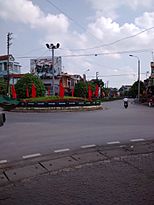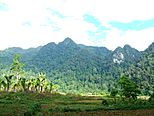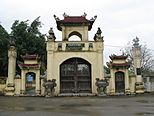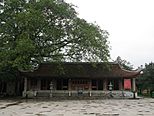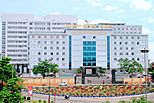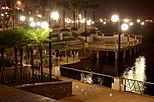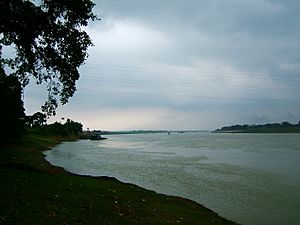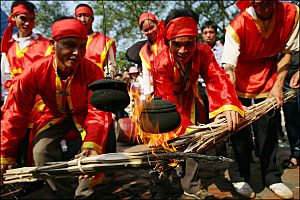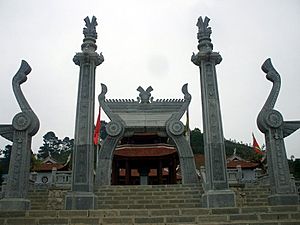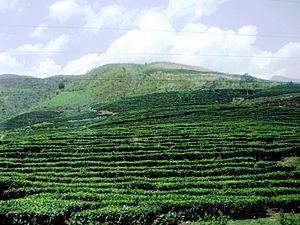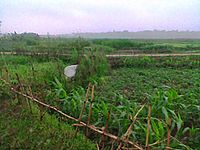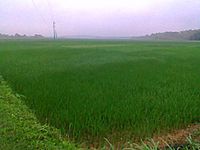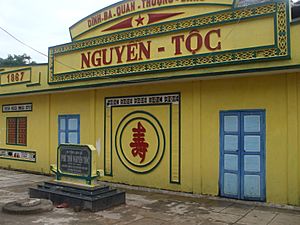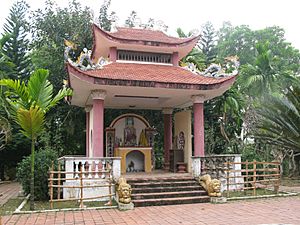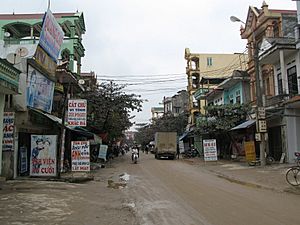Phú Thọ province facts for kids
Quick facts for kids
Phú Thọ province
Tỉnh Phú Thọ
|
|
|---|---|
|
Hùng Temple • Việt Trì City • Xuân Sơn National Park • Mount Phú Thọ • Âu Cơ Temple • Hospital Phú Thọ • Văn Lang Park
|
|
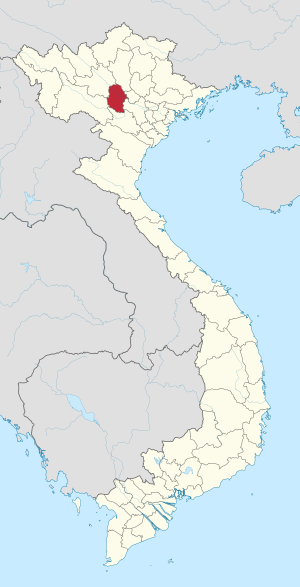
Location of Phú Thọ within Vietnam
|
|
| Country | |
| Region | Northeast |
| Capital | Việt Trì |
| Subdivision | 1 city, 1 district-level town, 11 rural districts |
| Government | |
| • Type | Province |
| • Body | Phú Thọ People's Council |
| Area | |
| • Province | 3,534.6 km2 (1,364.7 sq mi) |
| Population
(2021)
|
|
| • Province | 1,470,378 |
| • Density | 415.996/km2 (1,077.424/sq mi) |
| • Urban | 270,348 |
| Ethnic groups | |
| • Vietnamese | 82.95% |
| • Mường | 14.92% |
| • Dao | 1.07% |
| • Others | 1.06% |
| Time zone | UTC+7 (ICT) |
| Area codes | 210 |
| ISO 3166 code | VN-68 |
Phú Thọ (Vietnamese: [fu˧˦ tʰɔ˧˨ʔ]) is a province in northern Vietnam. Its capital city is Việt Trì. This city is about 80 kilometres (50 mi) from Hanoi.
Phú Thọ covers an area of about 3,534 square kilometers. In 2019, it had a population of over 1.4 million people. The province is known as the "West Gate of Hanoi". This is because of its important location. It sits where the Red River and Da River meet. It also connects the flat Red River Delta with the northern mountains.
The history of Phú Thọ is very old. It is linked to the Hùng kings. These kings are believed to have built the first Vietnamese nation, called Văn Lang. The Xuân Sơn National Park is also in Phú Thọ. It is a large park with lots of natural forests and limestone mountains. Tea farming is a very important part of the province's economy. The Hung Kings temple complex is a famous historical site here.
Contents
History of Phú Thọ
The history of Phú Thọ goes back to ancient times, around 3000 BC. This area was part of the first Vietnamese state, called Xich Quy. The rulers of this time are known as the Hùng kings. Later, the capital moved to Phong Châu, which is in Phú Thọ province.
The Hùng Temple complex was built on Nghĩa Lĩnh mountain. It honors the Hùng kings who created the nation. Many festivals in the province celebrate this long history.
Geography and Climate
Phú Thọ province covers about 3,528.1 square kilometres (1,362.2 sq mi). It is located in northern Vietnam. The province is like a triangle at the start of the Red River Delta. It is surrounded by other provinces. These include Tuyên Quang, Yên Bài, Sơn La, Hòa Bình, Hà Tây, Hà Giang, and Vĩnh Phúc. All these provinces connect to Hanoi, the capital of Vietnam.
Phú Thọ is called the "West Gate of Hanoi" because of its key location. It is where the Red and Da Rivers meet. This makes it a link between the northern provinces and the mountainous areas. It also connects to two Chinese provinces, Guangxi and Yunnan.
What is the climate like?
Phú Thọ has a subtropical monsoon climate. This means it has warm, wet summers and mild, dry winters. The average temperature is about 23.5 °C (74.3 °F). The hottest month is July, with temperatures around 29 °C (84 °F). The coolest month is February, with temperatures around 15 °C (59 °F).
The province gets a lot of rain, between 1,600 millimetres (63 in) and 1,800 millimetres (71 in) each year. Most of the rain falls during the monsoon season, from May to October. During this time, the air is very humid, with an average of 85% humidity. In the dry season, it drops below 80%.
Water and Mineral Resources
Three big rivers flow through Phú Thọ: the Red, Lô, and Da rivers. These rivers provide plenty of water for people and industries. They flow for about 200 kilometers through the province. The rivers supply about 42 billion cubic meters of water each year.
Phú Thọ also has some mineral resources. These include kaolin, feldspar, and spirit ores. There is also stone and gravel sand for building. Mineral water is found here too.
Xuân Sơn National Park
The Xuân Sơn National Park was created in February 2002. It is about 80 kilometers from Việt Trì City. The park covers a large area of 15,048 hectares (37,180 acres). Over 11,000 hectares (27,000 acres) of this is natural forest. Another 1,396 hectares (3,450 acres) is limestone-mountain forests.
The park is home to many different plants and animals. There are about 465 types of plants. It also has 282 types of animals. These include 23 kinds of amphibians, 30 kinds of reptiles, 168 kinds of birds, and 61 kinds of mammals. Rare animals like Tibetan bears, white pheasants, gray gibbons, and cobras live in the park.
The highest points in the park are Mount Voi (1,387m), Mount Ten (1,244m), and Mount Cẩn (1,144m). These mountains have many caves and grottoes. Some run 7–8 kilometers deep and are home to many bats.
Administrative Divisions
Phú Thọ province is divided into 13 main areas. These include:
- 11 districts:
-
- Cẩm Khê
- Đoan Hùng
- Hạ Hòa
- Lâm Thao
- Phù Ninh
- Tam Nông
- Tân Sơn
- Thanh Ba
- Thanh Sơn
- Thanh Thủy
- Yên Lập
- 1 district-level town:
- Phú Thọ
- 1 provincial city:
- Việt Trì (which is the capital)
These areas are further divided into smaller towns, communes, and wards.
Table of local government divisions
| Name | Division type | Population (2003) | Area (km2) | Towns (huyện lỵ or thị trấn) (bold) and communes (xã) |
|---|---|---|---|---|
| Việt Trì | City (thành phố) | 415,280 | 110 | Wards (phường): Bạch Hạc, Thanh Miếu, Thọ Sơn, Tiên Cát, Nông Trang, Vân Cơ, Bến Gót, Gia Cẩm, Tân Dân, Dữu Lâu, Minh Nông, Minh Phương, Vân Phú. Communes (xã): Thuỵ Vân, Phượng Lâu, Sông Lô, Trưng Vương, Hy Cương, Chu Hoá, Thanh Đình, Hùng Lô, Kim Đức, Tân Đức. |
| Phú Thọ | Township (thị xã) | 63,333 | 64 | Wards (phường): Hùng Vương, Phong Châu, Âu Cơ, Thanh Vinh, Trường Thịnh. Communes (xã): Hà Lộc, Văn Lung, Phú Hộ, Hà Thạch, Thanh Minh. |
| Cẩm Khê District | District (huyện) | 128,537 | 234.2 | Sông Thao, Cát Trù, Cấp Dẫn, Chương Xá, Điêu Lương, Đồng Cam, Đồng Lương, Hiền Đa, Hương Lung, Ngô Xá, Phú Khê, Phú Lạc, Phùng Xá, Phương Xá, Phượng Vĩ, Sai Nga, Sơn Nga, Sơn Tình, Tam Sơn, Tạ Xá, Thanh Nga, Thụy Liễu, Tiên Lương, Tình Cương, Tùng Khê, Tuy Lộc, Văn Bán, Văn Khúc, Xương Thịnh, Yên Dưỡng, Yên Tậρ |
| Đoan Hùng District | District (huyện) | 105,242 | 302 | Đoan Hùng, Đông Khê, Nghinh Xuyên, Hùng Quan, Vân Du, Chí Đám, Hữu Đô, Đại Nghĩa, Phú Thứ, Hùng Long, Vụ Quang, Minh Phú, Chân Mộng, Vân Đồn, Minh Tiến, Tiêu Sơn, Yên Kiện, Sóc Đăng, Ngọc Quan, Phong Phú, Phương Trung, Tây Cốc, Ca đình, Phúc Lai, Quế Lâm, Bằng Luân, Bằng Doãn, Minh Lương |
| Hạ Hòa District | District (huyện) | 108,556 | 340 | Hạ Hòa, Lệnh Khanh, Cáo Điền, Ấm Hạ, Phương Viên, Hậu Bổng, Đại Phạm, Đan Hà, Gia Điền, Y Sơn, Yên Luật, Lang Sơn, Chính Công, Yên Kỳ, Mai Tùng, Liên Phương, Hà Lương, Hương Xạ, Vụ Cầu, Minh Hạc, Vĩnh Chân, Phụ Khánh, Đan Thượng, Minh Côi, Văn Lang, Vô Tranh, Bằng Giã, Chuế Lưu, Xuân Áng, Lâm Lợi, Quân Khê, Hiền Lương, Động Lâm. |
| Lâm Thao District | District (huyện) | 106,610 | 115 | Lâm Thao, Hùng Sơn, Xuân Huy, Thạch Sơn, Tiên Kiên, Sơn Vi, Hợp Hải, Kinh Kệ, Bản Nguyên, Vĩnh Lại, Tứ Xã, Sơn Dương, Xuân Lũng, Cao Xá. |
| Phù Ninh District | District (huyện) | 114,048 | 167 | Phong Châu, Trạm Thản, Tiên Phú, Liên Hoa, Vĩnh Phú, Trung Giáp, Bảo Thanh, Trị Quận, Hạ Giáp, Gia Thanh, Phú Nham, Phú Lộc, Tiên Du, Phù Ninh, An Đạo, Tử Đà, Bình Bộ, Phú Mỹ, Lệ Mỹ. |
| Tam Nông District | District (huyện) | 82,370 | 156 | Hưng Hóa, Hùng Đô, Quang Húc, Hiền Quan, Thanh Uyên, Tam Cường, Văn Lương, Cổ Tiết, Hương Nộn, Thọ Văn, Dị Nậu, Dân Quyền, Phương thịnh, Tề Lễ, Tứ Mỹ, Xuân Quang, Hương Nha, Vực Trường. |
| Tân Sơn District | District (huyện) | 75,897 | 688.6 | Minh Đài, Tân Phú, Mỹ Thuận, Thu Ngạc, Thạch Kiệt, Thu Cúc, Lai Đồng, Đồng Sơn, Tân Sơn, Kiệt Sơn, Xuân Đài, Kim Thượng, Xuân Sơn, Văn Luông, Long Cốc, Tam Thanh,Vinh Tiền. |
| Thanh Ba District | District (huyện) | 109,806 | 194 | Thanh Ba, Đồng Xuân, Lương Lỗ, Hanh Cù, Yển Khê, Vũ Yển, Phương Lĩnh, Mạn Lạn, Hoàng Cương, Thanh Xá, Chí Tiên, Sơn Cương, Đỗ Sơn, Thanh Hà, Đông Thành, Khải Xuân, Võ Lao, Quảng Nạp, Ninh Dân, Yên Nội, Thái Ninh, Đông Lĩnh, Đại An, Năng Yên, Đỗ Xuyên, Thanh Vân, Vân Lĩnh. |
| Thanh Sơn District | District (huyện) | 187,700 | 1309 | Thanh Sơn, Sơn Hùng, Địch Quả, Giáp Lai, Thục Luyện, Võ Miếu, Thạch Khoán, Cự Thắng, Tất Thắng, Văn Miếu, Cự Đồng, Thắng Sơn, Tân Minh, Hương Cần, Khả Cửu, Tân Lập, Đông Cửu, Yên Lãng, Yên Lương, Thượng Cửu, Lương Nha, Yên Sơn, Tinh Nhuệ. |
| Thanh Thủy District | District (huyện) | 76,330 | 124 | Thanh Thủy, Xuân Lộc, Thạch Đồng, Tân Phương, La Phù, Bảo Yên, Đoan Hạ, Sơn Thủy (Son Vi, Thuy Tram, Phu Lao), Hoàng Xá, Trung Thịnh, Đồng Luận, Trung Nghĩa, Phượng Mao, Yến Mao, Tu Vũ, Đào Xá. |
| Yên Lập District | District (huyện) | 79,548 | 437 | Yên Lập, Mỹ Lung, Mỹ Lương, Lương Sơn, Xuân An, Xuân Viên, Xuân Thủy, Hưng Long, Thượng Long, Nga Hoàng, Trung Sơn, Đồng Thịnh, Phúc Khánh, Ngọc Lập, Ngọc Đồng, Minh Hòa, Đồng Lạc. |
People of Phú Thọ
In 2008, Phú Thọ province had a population of about 1,364,700 people. This makes it one of the less populated provinces in northern Vietnam. Most people live in rural areas. About 20% of the population lives in cities.
The main ethnic groups living in Phú Thọ are:
- Vietnamese (Kinh)
- Mường
- Dao
- Sán Chay
The Dao build their homes in traditional ways. Some are on stilts, some are on the ground, and some are a mix of both. Du village, inside Xuân Sơn National Park, is a popular place to visit. It has many Dao people living there.
Economy of Phú Thọ
Phú Thọ is one of the poorer areas in Vietnam. Many families earn less than $6 USD per person each month. In 1997, the economy was split evenly. About one-third of workers were in agriculture, one-third in industry, and one-third in services. The city of Việt Trì is a major center for businesses and industries in the province.
Tea is a very important crop for Phú Thọ's economy. It is the main industrial crop. The tea industry started in Vietnam in the mid-19th century. Phú Thọ province was a key area for tea plantations.
By 2001, about 8,400 hectares (21,000 acres) of land was used for tea. The province produces about 31,000 tons of fresh tea each year. This makes about 7,000 tons of dry tea. Over 15,000 families in Phú Thọ are involved in growing tea.
The French agency Agence Française de Développement (AFD) helps with tea production. They have a program to develop tea farming in eight districts. This project helps rural families earn more money and live better. It has also improved roads in the area.
Phú Thọ also grows grapefruit, palm oil, rice, and cassava. People catch freshwater fish in the Red River. In 2007, the province's industrial output was 11,705.1 billion đồngs.
Culture and Festivals
Đền Hùng is a national historical site. Vietnamese people visit it to honor the Hung kings. These kings made important contributions to the country 4000 years ago.
Hung Kings Temple Complex
The Hung Kings Temple is on Nghĩa Lĩnh Mountain. It is 175 meters above sea level in Việt Trì city. This complex has many grand buildings. It includes the Hạ Temple, Thiền Quang pagoda, Giếng Temple, Trung Temple, Thuong Temple, and King Hung's tomb.
The Hạ Temple was built in the 15th century. A 700-year-old tree stands in front of it. A legend says that Âu Cơ gave birth to 100 children here. Her husband, Lạc Long Quân, took 50 children to the coast. Âu Cơ took 49 children to the mountains. The oldest child became the Hùng king. He named the country Văn Lang and made Phong Châu its capital.
The Thuong Temple is reached by 102 brick steps from Trung Temple. Kings used to worship the Sun God, Earth God, and Rice God here. At this temple, the last Hùng king gave his kingdom to Thục Phán. He made a promise to protect the temple and the Hung family's legacy.
King Hung's tomb is where a ruler from the 6th Hung dynasty is buried. It is said that this king died at this spot after defeating invaders. Giếng Temple is at the foot of the mountain. It is where the 18th dynasty king's daughters, Ngọc Hoa and Tiên Dung, used to groom their hair using the well's water.
Hung Temple Festival
The "Hung Temple Festival" is a big event. It happens from the 8th to the 11th day of the third lunar month. The main celebration is on the 10th day. It takes place on Nghĩa Lĩnh Mountain in Việt Trì City.
During this festival, people honor the 18 dynasties of Hung kings. They are celebrated for creating the ancient Văn Lang State. This state was the start of modern Vietnam. The festival is a time of great pride for the homeland and ancestors. Many people, including government officials, join the festivities.
A large parade features 100 young men and women in traditional clothes. They represent the children of the "Dragon and Fairy." After the parade, there are performances. These include Xoan singing (folk songs) in the Thuong Temple and classical opera in the Hà Temple. Other fun activities include bamboo swings, nem con (throwing a sacred ball), cham thau (beating bronze drums), and dam duong (pounding rice).
Education and Transport
Phú Thọ has a good education system. It includes Hung Vuong University, many colleges, and vocational schools. These schools help train skilled workers for the province. There are 542 schools with over 300,000 students. There are also three colleges and one pre-university.
How to get around?
The province has excellent connections by roads, railways, and water. This helps its economy grow.
- Roads
Important roads include National Highway No. 2. This road goes from China's Yunnan province through Phú Thọ to Nội Bài International Airport. It then continues to Haiphong. Other highways connect Phú Thọ to different parts of Vietnam and even to Laos. The Tran-Asian road and the Hồ Chí Minh trail also pass through the province.
- Railway
A Trans-Asia railway line runs through Phú Thọ. It connects Yunnan in China to Hanoi. This railway also links to other major railway lines in Vietnam. It connects to two industrial zones in the province.
- Water transport
Việt Trì City has an important river port. It is located where three major rivers meet. This waterway is the main route for water transport in the province. Việt Trì's river port is one of the largest in Vietnam. It can handle 1 million tons of goods each year.
Other Facilities
Phú Thọ has a very stable electricity system. All local districts are connected to the national power grid. Việt Trì City and its nearby areas get safe drinking water from a modern plant. This plant can provide 42,000 cubic meters of water per day. Postal and phone services are also well-developed for both local and international communication.
See also
 In Spanish: Provincia de Phú Thọ para niños
In Spanish: Provincia de Phú Thọ para niños



